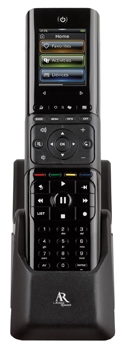Acoustic Research XSight Touch Remote Control

The biggest bugaboo for home theater DIYers is controlling the assortment of ins, outs, ons, and offs that make audio/video system components get along with one another. Most surround receivers, and even many televisions, come bundled with what their makers call "universal" remotes, but they hardly do respect to that word.
What I expect from a universal remote is more than just the ability to turn five or six components on and off. I expect it to control volume, switch inputs and surround sound modes, and seamlessly jump between activities as diverse as playing music from a media server and playing Rock Band on a game console, all without having to be reminded what HDMI or optical cable should be engaged, what surround mode should be active, and what I like to drink during Lost.
Aside from (cough…) paying someone to program an advanced control system, the next best thing is to buy an advanced universal learning remote. In recent years, the market for really good remotes has, not surprisingly, grown almost as fast as the market for home theater systems. Acoustic Research recently hit the streets with its XSight line, which includes two models, the Touch ($249) and the Color ($179). The more advanced of the two is the Touch, which packs a small color LCD touchscreen, a rechargeable lithium-ion battery, and built-in radio-frequency control for operating hidden components (with AR's optional $99.99 RF extender), all in a typical wand-style handheld controller.
SETUP
| Like many universal remotes, the XSight doesn't require any PC setup for basic device control. This means that once it's charged up, you can plant yourself in front of your gear and start programming the unit. It comes with thousands of built-in device codes and a very easy-to-follow onscreen guide to walk you step by step though the programming process. In this sense, it's similar to Universal Remote Control's R50. When programming the XSight, you're prompted to select from standard A/V devices (TV, DVD player, cable box) and then narrow your choice by brand. The remote then directs you to test it out by throwing some IR signals around until you find one that works. This method is worlds better than flipping through pages of remote codes and then plugging them in manually. I had a TV, surround receiver, cable box, and DVD player programmed in about 10 minutes. One more step added universal volume control to the whole getup. At this point, a lot of people would be finished. In fact, most universal remotes end at individual device control - but we want so much more… |  |
|---|
For the XSight to take the next step from a simple replacement remote to a serious controller, you need to hook it up to a PC (via USB). This is where it starts acting less like a URC R50 and more like a Logitech Harmony model. (Two Harmony Ones currently reside in my house.) The XSight comes with a CD containing the setup software. Once installed, the application launches in a Web browser (Firefox isn't supported) and starts prompting you through a series of configuration Qs and As. After programming in your TV and components (all over again for me), you then assign those devices to activities such as Watch TV, Listen to Music, and Watch Movie.
The software is fairly consumer-friendly compared with equivalent applications from Philips (Pronto remotes) and Universal Remote Control, but it's not as intuitive as Logitech's Harmony software. AR's application is slow, sometimes taking up to a minute just to search for model numbers. Also, the user is prompted to disconnect the remote from the computer several times during the process of setting up Activities, which causes the whole endeavor to drag on. The bright side of Activities setup is that you can program macros - a function where several commands are sent out at one time - without necessarily even knowing you're doing it. Another nice feature allows you to create personalized profiles for different family members - so it will operate slightly differently for you than for your kids, including showing separate Favorite Channel lists.
- Log in or register to post comments














































